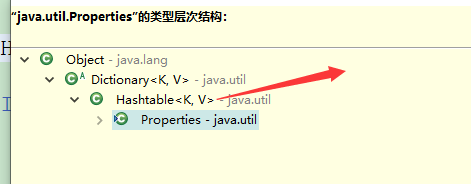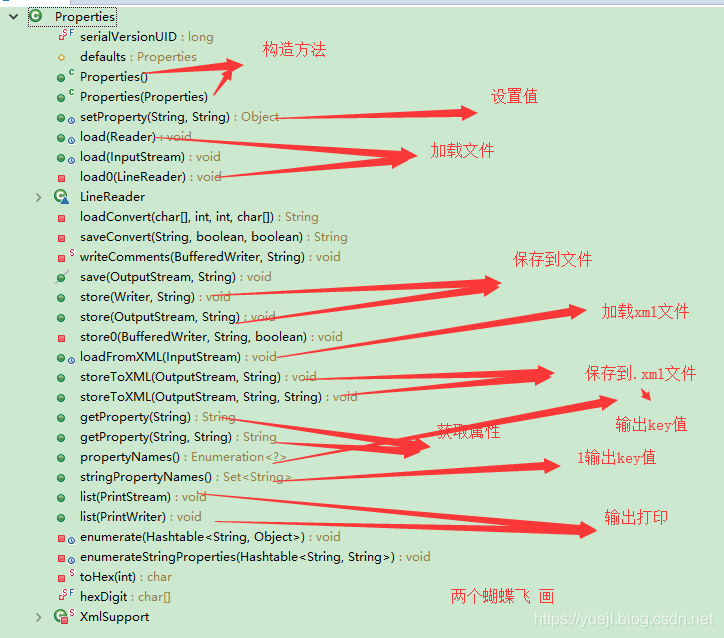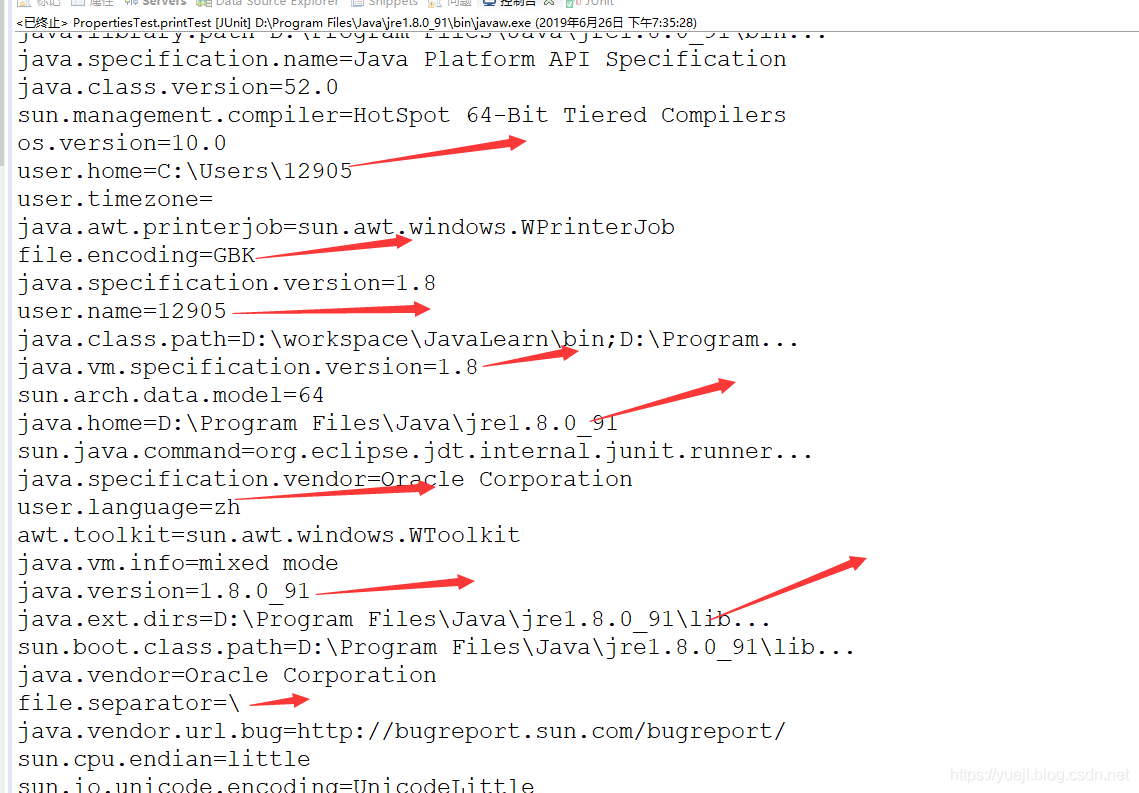我把你的头像,设置成我的名字,此刻你便与我同在。
我把你的名字,写进我的代码里面,以后,我的世界便存在着你。
一.Properties 类
Properties 类位于 java.util.Properties ,是Java 语言的配置文件所使用的类, Xxx.properties 为Java 语言常见的配置文件,如数据库的配置 jdbc.properties, 系统参数配置 system.properties。 这里,讲解一下Properties 类的具体使用。
以key=value 的 键值对的形式进行存储值。 key值不能重复。

继承了Hashtable 类,以Map 的形式进行放置值, put(key,value) get(key)
主要方法:

这里只讲解一些常用的形式。
二. 打印 JVM 参数
JVM 中可以获取Properties, 来打印输出 JVM 所了解的属性值。
用list() 方法,打印到控制台。
@Test
public void printTest(){
Properties properties=System.getProperties();
properties.list(System.out);
}
常见的有:

三.打印自定义.properties 文件中的值
在src 目录下,放置 jdbc.properties 文件,是数据库的配置文件。
jdbc.driver=com.mysql.jdbc.Driver
jdbc.url=jdbc:mysql://localhost:3306/mybatis?characterEncoding=utf8
jdbc.username=root
jdbc.password=abc123
三.一 list 输出到控制台 用绝对路径加载
@Test
public void name1Test(){
try{
Properties properties=new Properties();
//用的是磁盘符的绝对路径
InputStream input=new BufferedInputStream(new FileInputStream("D:\\workspace\\JavaLearn\\src\\jdbc.properties"));
properties.load(input);
properties.list(System.out);
}catch(Exception e){
e.printStackTrace();
}
}
url 被截取了。

三.二 propertyNames 输出 getClass() 加载
@Test
public void name2Test(){
try{
Properties properties=new Properties(); // 用/文件名, / 表示根目录
InputStream input=PropertiesTest.class.getClass().getResourceAsStream("/jdbc.properties");
properties.load(input);
Enumeration names=(Enumeration) properties.propertyNames();
while(names.hasMoreElements()){
//这是key值
String key=names.nextElement();
String value=properties.getProperty(key);
System.out.println(key+"="+value);
}
}catch(Exception e){
e.printStackTrace();
}
}

三.三 stringPropertyNames 输出 getClassLoader 加载 (推荐)
@Test
public void name3Test(){
try{
Properties properties=new Properties();
//直接写src 类路径下的文件名
InputStream input=PropertiesTest.class.getClassLoader().getResourceAsStream("jdbc.properties");
properties.load(input);
//把key值转换成set 的形式,遍历set
Set names=properties.stringPropertyNames();
Iterator iterator=names.iterator();
while(iterator.hasNext()){
String key=iterator.next();
String value=properties.getProperty(key);
System.out.println(key+"="+value);
}
}catch(Exception e){
e.printStackTrace();
}
}

四. 获取值 getProperties
@Test
public void name3Test(){
try{
Properties properties=new Properties();
InputStream input=PropertiesTest.class.getClassLoader().getResourceAsStream("jdbc.properties");
properties.load(input);
//String value=properties.getProperty("jdbc.url");
String value=properties.getProperty("jdbc.url1","没有该key值");
System.out.println("输出值:"+value);
}catch(Exception e){
e.printStackTrace();
}
}
输出时,getProperty() 有当前的key值,则输出Key值对应的value 值。
如果没有key值,则输出 null 值。
后面可以跟 default 值,如果没有该值,则输出设置的默认值。

五. 写入到Properties 文件
五.一 普通写入,中文时乱码
@Test
public void writeTest(){
try{
Properties properties=new Properties();
InputStream input=PropertiesTest.class.getClassLoader().getResourceAsStream("jdbc.properties");
properties.load(input);
//多添加几个值。
properties.setProperty("name","两个蝴蝶飞");
properties.setProperty("sex","男");
//properties.put("name","两个蝴蝶飞"); 可以用继承Hashtable 的put 方法写入值
// properties.put("sex","男");
//将添加的值,连同以前的值一起写入 新的属性文件里面。
OutputStream out=new FileOutputStream("D:\\jdbc.properties");
properties.store(out,"填充数据");
}catch(Exception e){
e.printStackTrace();
}
}

五.二 解决乱码写入的问题
在构建输入流和输出流时,指定编码格式, 编码的格式相同。 如均是 utf-8的形式。
@Test
public void write2Test(){
try{
Properties properties=new Properties();
//用绝对路径
InputStream input=new BufferedInputStream(new FileInputStream("D:\\workspace\\JavaLearn\\src\\jdbc.properties"));
properties.load(new InputStreamReader(input,"utf-8"));
//多添加几个值。
properties.setProperty("name","两个蝴蝶飞");
properties.setProperty("sex","男");
OutputStream output=new FileOutputStream("D:\\jdbc.properties");
OutputStreamWriter out=new OutputStreamWriter(output,"utf-8");
properties.store(out,"填充数据");
}catch(Exception e){
e.printStackTrace();
}
}
测试运行之后:

这样便解决了乱码的问题。
六 . 加载和导出到 xml 配置文件
六.一 导出到 .xml 配置文件 storeToXML
将Properties 类中定义的属性,导出成 .xml 的形式.
@Test
public void xmlWriteTest(){
try{
//处理成编码样式。
Properties properties=new Properties();
//多添加几个值。
properties.setProperty("name","两个蝴蝶飞");
properties.setProperty("sex","男");
OutputStream output=new FileOutputStream("D:\\jdbc.xml");
//编码设置成utf-8的形式。
properties.storeToXML(output,"填充到xml","utf-8");
}catch(Exception e){
e.printStackTrace();
}
}
测试结果为:

用 节点 key为属性, 后面跟值来进行输入。
可按照这种形式,继续添加。
六.二 导出XML 配置文件 loadFromXML
@Test
public void xmlReadTest(){
try{
Properties properties=new Properties();
InputStream input=new BufferedInputStream(new FileInputStream("D:\\jdbc.xml"));
properties.loadFromXML(input);
properties.list(System.out);
}catch(Exception e){
e.printStackTrace();
}
}

这就是Properties 类的常见用法 。
到此这篇关于Java中Properties 类的详细使用的文章就介绍到这了,更多相关Properties 类使用内容请搜索脚本之家以前的文章或继续浏览下面的相关文章希望大家以后多多支持脚本之家!





















 1万+
1万+











 被折叠的 条评论
为什么被折叠?
被折叠的 条评论
为什么被折叠?








